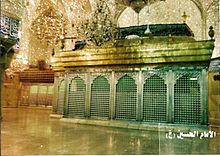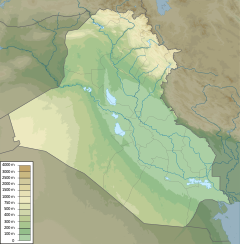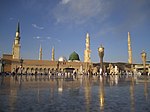| Imam Husayn shrine | |
|---|---|
مَقَام ٱلْإِمام ٱلْحُسَيْن ٱبْن عَلِيّ | |
| Religion | |
| Affiliation | Islam |
| Rite | Shia Islam |
| Ecclesiastical or organisational status | Mosque and shrine |
| Status | Active |
| Location | |
| Location | Karbala, Iraq |
| Geographic coordinates | 32°36′59″N 44°01′57″E / 32.61639°N 44.03250°E |
| Architecture | |
| Type | Abbasid architecture, Islamic architecture |
| Completed | 680 CE |
| Specifications | |
| Dome(s) | 2 |
| Dome height (outer) | 27 metres (89 ft) |
| Minaret(s) | 2 (formerly 3) |
The Imam al Husayn shrine (Arabic: مَقَاما الإِمَامُ الْحُسَيْن اِبِنْ عَلي, romanized: Maqām al-ʾImām al-Ḥusayn ʾibn ʿAlī) is the mosque and burial site of Husayn ibn Ali, in the holy city of Karbala, Iraq. It stands on the site of the Mausoleum of Husayn, who was a grandson of Muhammad, near the place where he embraced martyrdom during the Battle of Karbala in 680 CE.[1][2] The tomb of Husayn is one of the holiest sites in Shia Islam, outside of Mecca and Medina, and many make pilgrimages to the site. Every year, millions of pilgrims visit the city to observe Ashura, which marks the commemoration of Husayn's death for all Muslims.[3]
Description
The boundary wall of the shrine surrounds wooden gates covered with glass decorations. The gates open into a courtyard separated into smaller rooms or precincts with many "Iwans" along the walls. The grave of Husayn is enclosed within a metal-mesh like structure, found directly beneath the golden dome. On 5 March 2013, the process of replacing the zarih (metal mesh like structure) over the tomb of Husayn was completed and the new zarih inaugurated.[4] Al Abbas Mosque is located nearby. Plans to replace the shrine's historic dome with a modern steel framed one have been met with controversy, especially by historic preservationists, as it would severely distort the shrine's historic integrity and character.[5]

The first dome is 27 metres (89 ft) high and completely covered with gold. At the bottom, it is surrounded with twelve windows, each of which is about 1.25 metres (4 ft 1 in) away from the other, from the inside, and 1.30 metres (4 ft 3 in) from the outside. The shrine has an area of 59 metres (194 ft) by 75 metres (246 ft) with ten gates, and about 65 decorated rooms used for studying.
Burials


The grave of Husayn ibn Ali is found in the middle of the precinct, it is called the Rawḍah ("garden") and it has several doors. The most famous one is called Al-Qiblah or Bāb al-Zah'ab. On the right hand side of the entrance is the tomb of Habīb ibn Madhahir al-Asadī (حبیب ابن مظاهر الاسدی), a friend and companion of Husayn since their childhood and a casualty of the Battle of Karbala.
Within the shrine of Husayn can also be found a grave of all the 72 martyrs of Karbalā'. They were buried in a mass grave which was then covered with soil to the ground level. This mass grave is at the foot of Husayn's grave. Beside Husayn's grave, there are also the graves of his two sons: 'Alī al-Akbar and the six-month old, 'Alī al-Asghar. Along with the graves of the martyrs of Karbala, is also the grave of the very first custodian of Imam Husayn shrine, Ibrahim al-Mujab, grandson of seventh shi'ite Imam Musa al-Kazim.[6][7]
History


Husayn bought a piece of land after his arrival at Karbala' from Bani Asad. He and his Ahl al-Bayt are buried in that portion, known as al-Ḥā'ir(الحائر), where the shrines are presently located. The history of destruction and reconstruction of the shrines of Karbala' is long. Both the shrines were greatly extended by successive Muslim rulers, but suffered repeated destruction from attacking armies. Several rulers extended, decorated and kept the shrines and its precincts in good condition. Among them is Fath-Ali Shah Qajar, who in 1250 AH ordered the construction of two shrines, one over Husayn's grave and the other over the grave of his half-brother, Abbas ibn Ali.

From the time of Husayn ibn Ali's death in 680, pilgrimages to commemorate the massacre have often been repressed.[8] Despite many attempts by successive rulers, such as Al-Rashīd and Al-Mutawakkil, to put a restriction on the development of the area, it has nonetheless evolved into a city.

The historian Ibn Kuluwayh mentioned that those who buried Husayn ibn 'Alī constructed a special, durable identifying marker for the gravesite.
Larger, more significant construction on the gravesite began during the rule of al-Saffah (reign: 750–754 AD), the first caliph of the long-lasting Abbasid caliphate (an Islamic dynasty). However, heavy restrictions were put in place to prevent people from visiting the grave during the rule of Hārūn al-Rashīd, the fifth Abbasid caliph (reign: 786–809 AD).
During the rule of al-Mā'mūn, the seventh Abbasid caliph (reign: 813–833 AD), gravesite construction resumed until the year 850 AD, when al-Mutawakkil ordered the destruction of the grave and the filling of the resulting pit with water. His son who succeeded him as caliph, al-Muntasir, allowed people to visit the gravesite, and since then, building the precinct to the grave increased and developed step by step.
On the other hand, the historian Ibn al-Athir, stated that in the year 981 AD (371 AH), 'Adhud ad-Dawlah became the first to expansively lay the foundations for large-scale construction and to generously decorate the place. He also built houses and markets around the precinct, and surrounded Karbalā with a high boundary wall, turning it into a strong castle.
In the year 407 AH (1016 AD), the precinct caught fire due to the dropping of two large candles on the wooden decorations. The state minister at the time, Hasan ibn Fadl, rebuilt the damaged sections.
Timeline
The following events are in chronological order, stating instances that widely involved the shrine, impressing its construction, renovation and series of extremist activities that reduced its structure and killed pilgrims from time to time.
| Year | Event | |
|---|---|---|
| AH | CE | |
| 61 | 680 | 10 October: Husayn is said to have been buried on this day. It was Bani Asad who, after the departure of Ahl al-Bait, assembled at the grave of Husayn. Historical accounts provide little light on the first builder of the shrine. It is assumed that Bani Asad was also the first, who erected a tent upon the grave of Husayn. A Shaikh of Bani Asad lit a candle at the grave and planted a berry tree a few feet away from the side of the head of the grave, to indicate the grave of Husayn. |
| 65 | 684 | A shrine was built by Mukhtar ibn Abu 'Ubayd ath-Thaqafi on the spot and a dome was created over the grave. Over the dome he fixed a green flag. Two entrance gates were made for the shrine. He also settled several families around the enclosure. |
| 132 | 749 | Another dome was erected over the shrine and additional two gates for entrance were made at the mausoleum during the reign of Abbasid Caliph As-Saffah. |
| 140 | 763 | During the reign of Caliph al-Mansur, the roof along with the domes were destroyed. |
| 158 | 774 | The demolished roof was rebuilt during the reign of Caliph al-Mahdi. |
| 171 | 787 | During the reign of Caliph Harun ar-Rashid, the mausoleum was destroyed and the Berry tree that stood besides the grave of Husayn was cut down. Even then people kept visiting the grave of Husayn, guided by the traces of the 'Tree of the Berry', which covered the grave. Harun al-Rashid could not tolerate this, and ordered the tree to be cut off from the roots, with the intention to wipe out the sign of the grave of Husayn and stop the practice of visiting the grave. |
| 193 | 808 | The mausoleum was reconstructed during the reign of Caliph al-Mamun for political advantage against Al-Amin. |
| 236 | 850 | Caliph al-Mutawakkil destroyed the mausoleum and ordered the nearby land, including the grave, to be ploughed. The shrine was destroyed four times from 232 hijri until 246 hijri |
| 247 | 861 | Caliph al-Muntasir reconstructed the shrine with an iron pillar build a roof over the grave. Under instruction of Al Muntasir, new houses were built around the shrines. |
| 273 | 886 | Once again the mausoleum was destroyed on the order of Abbasid political and military leader Talha al-Muwaffaq ibn Jafar al-Mutawakkil or by al-Muktafi bi-lah |
| 280 | 893 | The shrine was rebuilt by the Alid council and two minarets were constructed on either side of the grave. Two entrance gates for the shrine were also constructed. |
| 307 | 977 | A sepulcher was constructed within the shrine using teak wood, by the Buwayhid emir 'Adhud ad-Dawlah. Surrounding galleries were also constructed. He also constructed the city of Karbala by making houses and the city boundary. 'Imrān ibn Shahin at that time also constructed a mosque adjacent to the shrine. |
| 407 | 1016 | Fire destroyed the shrine. The vizier Hasan ibn Fadl rebuilt the structure. |
| 620 | 1223 | The sepulcher was renovated by an-Nasir li-Din Allah. |
| 757 | 1365 | The dome and walls of the shrine were reconstructed by Sultan 'Uways ibn Hasan Jalayiri. He also raised the walls of the enclosure. |
| 780 | 1384 | The two minarets were reconstructed of gold by Sultan Ahmad ibn 'Uways. The courtyard was also extended. |
| 920 | 1514 | The Safavid shah of Iran Ismail I, constructed a sarcophagus of inlaid glass work over the real grave. |
| 1032 | 1622 | Abbas Shah Safavi renovated the sarcophagus with brass and bronze and also the dome with Kashi tiles. |
| 1048 | 1638 | Sultan Murad IV whitewashed the dome. |
| 1155 | 1742 | Nadir Shah Afshar decorated the shrine and offered expensive gems to the treasury of the shrine. |
| 1211 | 1796 | Aghā Muhammad Shāh Qājār covered the dome with gold. He also decorated the Min'ar and gold plated it. |
| 1216 | 1801 | Wahhabis under Abdulaziz bin Muhammad Al Saud attacked Karbala, damaged the shrine and looted the sepulchre.[9] |
| 1232 | 1817 | Fat'h 'Alī Shāh Qājār reconstructed the screens by plating with silver. He also replated the dome with gold and therefore repaired the damage caused by the Wahhabis. |
| 1283 | 1866 | Nāsir ad-Dīn Shāh Qājār broadened the courtyard of the mausoleum. |
| 1358 | 1939 | Syedna Taher Saifuddin, of the Dawoodi Bohra community presented a set of solid silver screens with gold which were attached to the shrine. This set is made of 500 gold coins (each coin consisted 12 grams weight) and 200 thousand coins of silver, beautified with precious gems. |
| 1360 | 1941 | The western minaret was rebuilt by Syedna Taher Saifuddin. He spent a considerable amount gold plating all the Min'ar. |
| 1367 | 1948 | A road was built around the shrine by the then administrator of Karbala City, Sayyid Abd al-Rasul al-Khalsi. He also broadened the courtyard of the shrine. |
| 1411 | 1991 | Major damage to the shrine occurs as the city experiences violent reprisals by the army of Saddam Hussein after an uprising against his regime following the Persian Gulf War. |
| 1415 | 1994 | Repairs to the shrine from the damage done in 1991 are completed.[10] |
| 1425 | 2004 | 2 March: At least 6 explosions[11] occurred during the 'Āshūrā' commemorations, killing 178 people and wounding 500.[12][13] |
| 1425 | 2004 | 15 December: A bomb detonated near the gate of the shrine, killing at least 7 people and injuring 31 others.[14][15] |
| 1426 | 2006 | 5 January: Suicide bombers among the crowd between the two shrines, killed at least 60 people and injured more than 100.[16][17] |
| 1428 | 2007 | 14 April: A suicide attack 200 m from the shrine killed at least 36 people and injured more than 160 others.[18][19] |
| 1428 | 2007 | December: Construction work began on building a roof over the courtyard of the shrine, with hopes of creating a second floor and expanding the shrine.[20] |
| 1429 | 2008 | 17 March: A female suicide bomber detonated herself in the market near the shrine, killing at least 42 people and injured 58 others.[21][22] |
| 1429 | 2008 | 11 September: A bomb was detonated 800 m from the shrine, killing one woman and injuring 12 others.[23] |
| 1430 | 2009 | 12 February: A bomb blast killed 8 people and wounded more than 50 others during the commemoration of Arba'een.[24][25] |
| 1431 | 2010 | Attacks aimed at pilgrims attending the commemoration of Arba'een: 1 February: A female suicide bomber detonated herself, killing 54 people and injuring more than 100 others.[26] 3 February: A bomb blast killed at least 23 people and injured more than 147.[citation needed] 5 February: A double bomb-blast,[26] or a combination of a bomb-blast and mortar attack[26] killed at least 42 people and left 150 injured.[citation needed] |
| 1433 | 2012 | Construction of a roof covering the courtyard around the shrine was completed, as pilgrims are increasing every year measures to enhance their experience are being taken.[27] |
| 1441 | 2019 | 10 September: 31 people were killed and approximately 100 more were injured in Karbala stampede during Ashura |
See also
| Part of a series on |
| Husayn |
|---|
Notes
- ^ Shimoni & Levine, 1974, p. 160.
- ^ Aghaie, 2004, pp. 10-11.
- ^ "Interactive Maps: Sunni & Shia: The Worlds of Islam". PBS. Archived from the original on 30 September 2007. Retrieved 9 June 2007.
- ^ "Archived copy". Archived from the original on 15 March 2014. Retrieved 7 March 2013.
{{cite web}}: CS1 maint: archived copy as title (link) - ^ "Imam Hussein Holy Shrine | Error". Archived from the original on 3 December 2020. Retrieved 7 December 2016.
- ^ Zayd, Nasr Hamid Abu (1999). "Qadiyah al-Maraah Bayna Sindan al-Hadathah wa-Mitraqah al-Taqalid: Dirasah fi Tarikh al-Nusus". Alif: Journal of Comparative Poetics (19): 29. doi:10.2307/521927. ISSN 1110-8673.
- ^ Karbāsī, Muḥammad Ṣādiq Muḥammad; كرباسي، محمد صادق محمد،. (1998). Tārīkh al-marāqid : al-Ḥusayn wa-ahl baytihi wa-anṣārih. Markaz al-Ḥusaynī lil-Dirāsāt., مركز الحسيني للدراسات. (al-Ṭabʻah 1 ed.). Landan: al-Markaz al-Ḥusaynīyah lil-Dirāsāt. ISBN 1-902490-08-8. OCLC 122859166.
- ^ al Musawi, 2006, p. 51.
- ^ Martin, Richard C., ed. (2003). Encyclopedia of Islam and the Muslim world. New York: Macmillan Reference USA. ISBN 0-02-865603-2. Retrieved 14 July 2016.
- ^ Paul Lewis (13 August 1994). "Karbala Journal; Who Hit the Mosques? Not Us, Baghdad Says". New York Times. Retrieved 15 November 2008.
- ^ "In pictures: Karbala blasts". BBC News. 2 March 2004. Retrieved 15 November 2008.
- ^ "Iraq Shias massacred on holy day". BBC News. 2 March 2004. Retrieved 15 November 2008.
- ^ "Deadly attacks rock Baghdad, Karbala". CNN.com. 2 March 2004. Retrieved 15 November 2008.
- ^ "Bomb at Shiite shrine kills seven on first day of Iraq's election campaign". USA Today. 15 December 2004. Retrieved 27 April 2009.
- ^ "Bomb at Shiite shrine kills seven in violence, wounds 31 on first day of Iraq's election campaign". SignOnSanDiego.com. Retrieved 27 April 2009.
- ^ "Iraq suicide bomb blasts kill 120". BBC News. 5 January 2006. Retrieved 15 November 2008.
- ^ Oppel Jr, Richard A. (6 January 2006). "Up to 130 Killed in Iraq, Drawing a Shiite Warning". The New York Times. Retrieved 15 November 2008.
- ^ "Iraq suicide bomb blasts kill 120". BBC News. 14 April 2007. Retrieved 16 November 2008.
- ^ "Dozens slain as car bomb hits Iraqi bus station". NBC News. 14 April 2007. Retrieved 16 November 2008.
- ^ تطورات مشروعي توسيع الحرم الحسيني المقدس وبناء المنشآت للطابق الثاني. العتبة الحسينية المقدسة (in Arabic). 18 December 2007. Archived from the original on 28 May 2010. Retrieved 6 February 2010.
- ^ "Dozens killed near Iraqi shrine". BBC News. 17 March 2008. Retrieved 16 November 2008.
- ^ "Death toll from Karbala suicide bombing rises to 35". Xinhua. 18 March 2008. Archived from the original on 23 March 2008. Retrieved 16 November 2008.
- ^ Jomana Karadsheh (11 September 2008). "3 killed in Iraq shrine bombings". CNN. Retrieved 15 November 2008.
- ^ "Iraq Violence". Associated Press. 13 February 2009. Archived from the original on 18 July 2011. Retrieved 6 February 2010.
- ^ "Iraq - International Religious Freedom Report 2009". U.S. Department of State. 26 October 2009. Archived from the original on 31 October 2009. Retrieved 6 February 2010.
- ^ a b c "Deadly blasts hit Iraq Karbala city". Al Jazeera. 6 February 2010. Retrieved 6 February 2010.
- ^ "Shrine of Husain ibn Ali". theshiapedia.com. Retrieved 27 March 2015.
References
- Aghaie, Kamran Scot (2004). The Martyrs of Karbala: Shi'i Symbols and Rituals in Modern Iran. University of Washington Press. ISBN 0-295-98448-1
- Litvak, Meir (1998). Shi'i Scholars of Nineteenth-Century Iraq: The Ulama of Najaf and Karbala. Cambridge University Press. ISBN 0-521-89296-1
- al Musawi, Muhsin (2006). Reading Iraq: Culture and Power and Conflict. I.B.Tauris. ISBN 1-84511-070-6
- Shimoni, Yaacov & Levine, Evyatar (1974). Political Dictionary of the Middle East in the 20th Century. Quadrangle/New York Times Book Co.
External links
![]() Media related to Imam Husayn Shrine at Wikimedia Commons
Media related to Imam Husayn Shrine at Wikimedia Commons
- In pictures: Pilgrims in Karbala - BBC News Online.
- Shia Shrines of Karbala - Sacred Destinations











